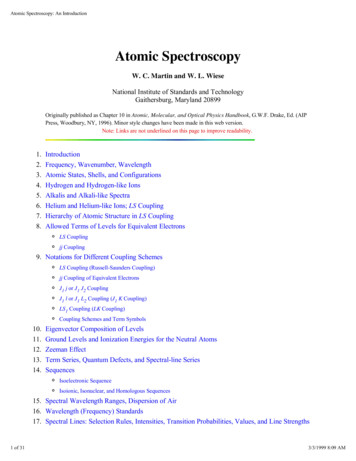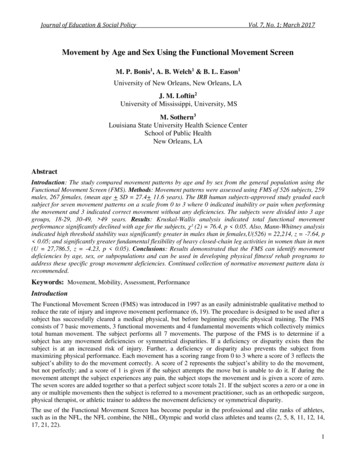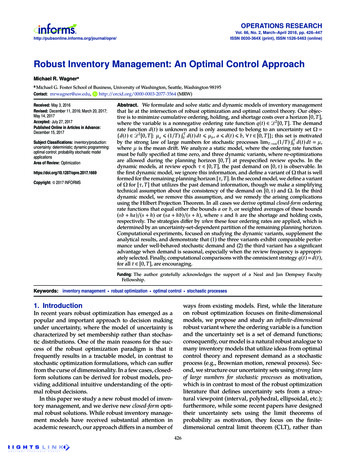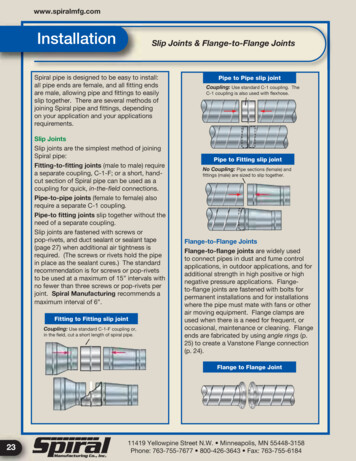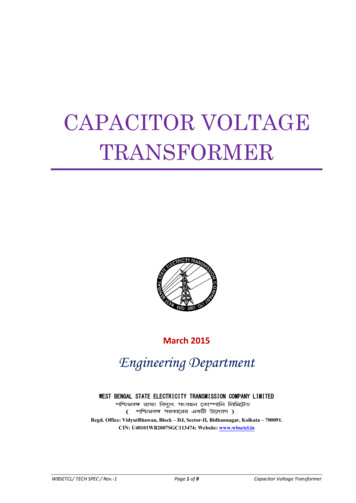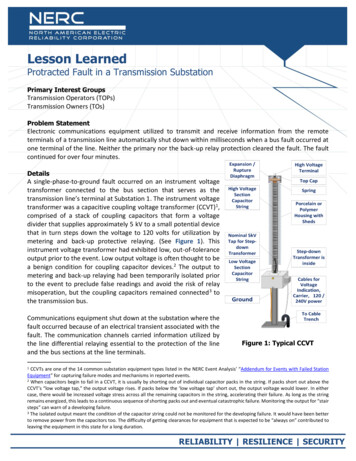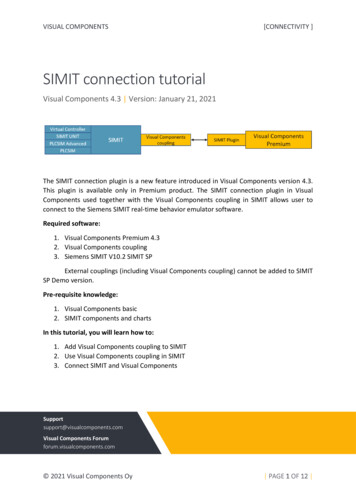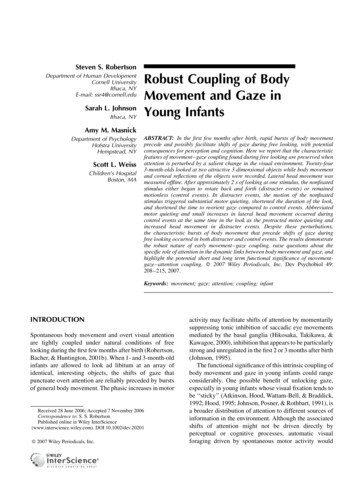
Transcription
Steven S. RobertsonDepartment of Human DevelopmentCornell UniversityIthaca, NYE-mail: ssr4@cornell.eduSarah L. JohnsonIthaca, NYRobust Coupling of BodyMovement and Gaze inYoung InfantsAmy M. MasnickDepartment of PsychologyHofstra UniversityHempstead, NYScott L. WeissChildren’s HospitalBoston, MAABSTRACT: In the first few months after birth, rapid bursts of body movementprecede and possibly facilitate shifts of gaze during free looking, with potentialconsequences for perception and cognition. Here we report that the characteristicfeatures of movement–gaze coupling found during free looking are preserved whenattention is perturbed by a salient change in the visual environment. Twenty-four3-month-olds looked at two attractive 3-dimensional objects while body movementand corneal reflections of the objects were recorded. Lateral head movement wasmeasured offline. After approximately 2 s of looking at one stimulus, the nonfixatedstimulus either began to rotate back and forth (distracter events) or remainedmotionless (control events). In distracter events, the motion of the nonfixatedstimulus triggered substantial motor quieting, shortened the duration of the look,and shortened the time to reorient gaze compared to control events. Abbreviatedmotor quieting and small increases in lateral head movement occurred duringcontrol events at the same time in the look as the protracted motor quieting andincreased head movement in distracter events. Despite these perturbations,the characteristic bursts of body movement that precede shifts of gaze duringfree looking occurred in both distracter and control events. The results demonstratethe robust nature of early movement–gaze coupling, raise questions about thespecific role of attention in the dynamic links between body movement and gaze, andhighlight the potential short and long term functional significance of movementgaze–attention coupling. ß 2007 Wiley Periodicals, Inc. Dev Psychobiol 49:208–215, 2007.Keywords: movement; gaze; attention; coupling; infantINTRODUCTIONSpontaneous body movement and overt visual attentionare tightly coupled under natural conditions of freelooking during the first few months after birth (Robertson,Bacher, & Huntington, 2001b). When 1- and 3-month-oldinfants are allowed to look ad libitum at an array ofidentical, interesting objects, the shifts of gaze thatpunctuate overt attention are reliably preceded by burstsof general body movement. The phasic increases in motorReceived 28 June 2006; Accepted 7 November 2006Correspondence to: S. S. RobertsonPublished online in Wiley InterScience(www.interscience.wiley.com). DOI 10.1002/dev.20201ß 2007 Wiley Periodicals, Inc.activity may facilitate shifts of attention by momentarilysuppressing tonic inhibition of saccadic eye movementsmediated by the basal ganglia (Hikosaka, Takikawa, &Kawagoe, 2000), inhibition that appears to be particularlystrong and unregulated in the first 2 or 3 months after birth(Johnson, 1995).The functional significance of this intrinsic coupling ofbody movement and gaze in young infants could rangeconsiderably. One possible benefit of unlocking gaze,especially in young infants whose visual fixation tends tobe ‘‘sticky’’ (Atkinson, Hood, Wattam-Bell, & Braddick,1992; Hood, 1995; Johnson, Posner, & Rothbart, 1991), isa broader distribution of attention to different sources ofinformation in the environment. Although the associatedshifts of attention might not be driven directly byperceptual or cognitive processes, automatic visualforaging driven by spontaneous motor activity would
Developmental Psychobiology. DOI 10.1002/devprovide important input for those rapidly developingsystems. In fact, dynamical models suggest that stochasticprocesses may play a central role in the organization offree looking by 1-month-olds (Robertson, Guckenheimer,Masnick, & Bacher, 2004), and spontaneous motoractivity in the first 3 months has chaotic properties thatmake it a likely candidate for the biological instantiationof such a stochastic process (Robertson, Bacher, &Huntington, 2001a).One possible adverse consequence of the intrinsiccoupling of body movement and gaze is the untimelyinterruption of attention. If gaze is unlocked too early byfluctuations in spontaneous motor activity, importantperceptual and cognitive processing of the informationbeing extracted from the targets of attention would be cutshort. In fact, recent evidence indicates that the extent towhich 3-month-olds do not suppress ongoing bodymovement at the onset of each new look predicts parentreported attention problems at 8 years of age (Friedman,Watamura, & Robertson, 2005). In addition, structuraland functional neuroimaging in older children and adultshas implicated the basal ganglia in the pathophysiology ofattention deficit/hyperactivity disorder (Bush, Valera, &Seidman, 2005; Casey, Tottenham, & Fossella, 2002;Seidman, Valera, & Makris, 2005) and behavioral studieshave revealed associated deficits in the control of visualfixation (Munoz, Armstrong, Hampton, & Moore, 2003;Sweeney, Takarae, Macmillan, Luna, & Minshew, 2004).Therefore, the likelihood that early movement–gazecoupling is mediated by the basal ganglia raises thepossibility of a developmental link to more seriousattention disorders in childhood.A balance between stability and interruptibility ofvisual attention has clear adaptive significance, and theavailable evidence suggests that the intrinsic coupling ofbody movement and gaze early in development may playan important role in the dynamic control of the balance.However, our knowledge of early movement–gazecoupling is limited to conditions of free looking duringwhich the underlying mechanisms are largely unperturbedby extrinsic events. Therefore, the present study wasdesigned to investigate the dynamic response of thecoupled system of body movement and gaze when theenvironment changes in a way that commands attention.Comparisons between perturbed and unperturbed conditions are likely to reveal important features of the linkbetween spontaneous motor activity and overt visualattention in young infants. Features that are present underboth conditions may play a more central role in the earlyintegration of action and perception. In particular, ifphasic motor activation helps unlock gaze in younginfants, thereby facilitating the redirection of attention,the motor activation should occur regardless of whetherthe redirection of attention is spontaneous or triggered byMovement–Gaze Coupling209an external event. Furthermore, the timing relationbetween bursts of body movement and shifts of gazeshould be preserved.METHODSSubjectsUsable data were obtained from 24 (11 female) healthy 3-monthold infants with no known motor or sensory deficits. All infantswere born after a full-term gestation (37–41 postmenstrualweeks, median 39 weeks) with birth weights between 2,743 and4,914 g (median 3,514 g) and studied between 82 and 87 days(median 84 days) after birth. Parents had indicated their potentialinterest in participating in research at the time of their infant’sbirth. An additional 16 infants participated but did not provideusable data due to insufficient interest in the stimulus objects(4 female, 2 male), fussiness (2 female, 6 male), or technicalproblems with recording equipment (1 female, 1 male). The24 infants who did and the 16 who did not provide usable data didnot differ on birth weight, gestational age, postnatal age, or sex(all ps .25).ProcedureSessions were scheduled at a time that parents indicated theirinfant was most likely to be alert and rested (actual times of studyranged from 8:30 am to 3:45 pm). After arrival in the lab and abrief adjustment period, infants were placed in a commercialinfant car seat approximately 90 cm from the stimuli, which weremounted in front of a black cloth screen. Additional blackcloth screens to the infants’ left and right minimized visualdistractions. Ambient light and sound levels were approximately300 lx, and 50 dbA, respectively. Data collection began as soonas the infant was comfortable and continued until the infant lostinterest or became fussy. For five infants, one or two additionaldata collection periods separated by brief rests provided usabledata. The total period of data collection for each infant rangedfrom 5.7 to 22.5 min (median 11.8 min).The stimuli were two identical objects (commerciallyavailable Big Bird toys with bright yellow head and body,orange feet, pink eyelids, blue eyelashes, and large black pupils)that subtended approximately 11 degrees of visual angle andwere separated horizontally by approximately 22 degrees ofvisual angle. A small incandescent lamp (type 1815) coveredwith yellow tape was mounted on the front of each object toincrease the brightness of the corneal reflections of the stimuli.The infant’s face, including the corneal reflections of the stimuli,were recorded on videotape (Panasonic AG-7350) from a camera(Cohu 4910) located behind a hole in the screen midway betweenthe stimuli.During data collection, an observer watched the cornealreflections of the stimuli on a video monitor and operated a3-position switch (center off) that indicated to the data acquisitionsoftware (Labview 5.1, National Instruments, Austin, TX) whenthe infant’s gaze shifted to and from each stimulus. Observerswere trained until their real-time performance met the following
210Developmental Psychobiology. DOI 10.1002/devRobertson et al.criteria based on the resolved frame-by-frame coding (seebelow) of the video recorded corneal reflections: (1) Less than2 percent of shifts on stimuli and 2 percent off were missed. (2)Less than 5 percent of recorded shifts on stimuli and 3 percent ofshifts off were false. (3) Less than 10 percent of correctlyidentified shifts on stimuli and 3 percent of shifts off wereanticipated, and the median anticipation for each was less than150 ms. (4) The median reaction time for the remaining correctlyidentified shifts was less than 400 ms for shifts on stimuli and300 ms for shifts off.When the duration of looking at one of the stimuli reached 2 s,a distracter or control event was initiated by the data acquisitionsoftware. In distracter events, the other (non-fixated) stimulusbegan to rotate 45 degrees back and forth at 1.25 cycles/s(moving alternately clockwise and counter clockwise from theinfant’s perspective). The stimulus continued to rotate for 1 safter the infant looked at it or until 10 s elapsed. Control eventswere identical to distracter events except that the nonfixatedstimulus was not activated. Distracter and control events wererandomly mixed (2 of each in blocks of 4).Infant body movement was detected by two piezoelectricsensors (Radio Shack speaker elements 273-091), one in theback and one in the bottom of the infant seat. Sensor output wasamplified (Coulbourn S75-01), band pass filtered (1–40 Hz;Coulbourn S75-34), and digitized (National InstrumentsAT-MIO-16H9) at 1/60 s intervals with 12-bit resolution. Analogto digital conversion was triggered at the beginning of each newvideo field by the camera recording the corneal reflections of thestimuli.Data Reduction and AnalysisVideo recordings of the corneal reflections of the stimuli wereused to determine the timing of gaze shifts on and off the stimulito the nearest video field. Criterion looks (those identified onlineas lasting at least 2 s and therefore triggering a distracter orcontrol event) were examined independently by two trainedcoders whose determination of the timing of shifts agreed towithin two video fields (1/30 s) for more than 90 percent of shifts.Any differences between the coders were resolved. Theevent triggered by the criterion look was considered valid ifthe resolved coding confirmed that the look lasted at least 2 sand did not end until at least 120 ms after the event was triggered.The number of valid distracter events per infant was5–25 (median 12) and the number of valid control events was4–25 (median 11); the range was due variation in the length oftime infants remained interested in the stimuli. The mediannumber of distracter events that were invalid because thecriterion look was shorter than 2 s or ended less than 120 ms afterevent onset was 2 for each reason. The median number of controlevents that were invalid was 3 and 1, respectively, for eachreason.Body movement sensor output was analyzed in 0.1 s binstime-locked to the onset of each event or to the subsequent gazeshift off the stimulus. The magnitude of sensor output thatexceeded thresholds set to exclude electrical noise and activitycaused by breathing movements was averaged within each bin.For each infant, the bin averages were normalized by subtractingthe mean and dividing by the standard deviation of all binaverages obtained for the infant.Head movement during each valid distracter and controlevent was measured from the video recording of cornealreflections for a random subset of 10 infants (6 female) withadequate image quality. A pattern-matching algorithm (NationalInstruments Vision 5.0) was used to track the change in positionof a distinctive facial feature (e.g., the nostrils) at 0.1 s intervals,time-locked to the onset of each event or to the subsequent gazeshift off the stimulus. Based on 113 representative events, themedian correlation between the head movement sequencesobtained by two independent analyses by different individualswas .98 and the median difference across the bins withinevents was less than 0.1 cm, corresponding to approximately0.7 degrees of rotational motion for an infant with a normal headshape (Hutchison, Hutchison, Thompson, & Mitchell, 2004)and median head circumference (Centers for Disease Control andPrevention, 2000). Lateral head movement as large as 1.0 cm/0.1 s did not itself produce detectable increases in the output ofthe body movement sensors with the sensor placement used inthis study.Normalized body movement and lateral head movementwere averaged separately for bins time-locked to event onset andgaze shift and for distracter and control events. Body and headmovement were analyzed using Event (distracter, control) byTime (16 0.1 s intervals) repeated measures analyses of variance.For analyses time-locked to event onset, the time intervalboundaries were 0.3, 0.2, . . ., 1.3 s relative to event onset. Foranalyses time-locked to gaze shift, the time interval boundarieswere 1.3, 1.2, . . ., 0.3 s relative to gaze shift. The timeintervals were selected to exclude effects associated with thepreceding and following looks. If there was a main effect ofTime, or an Event Time interaction, monotonic increases ordecreases over time intervals were evaluated further using t-testsof the corresponding slopes. Where relevant, the reportedp-values reflect the Huynh–Feldt correction for nonsphericity.RESULTSInterruption of Overt AttentionThe interval between look onset and event onset was thesame for distracter (2.92 0.08 s, mean SEM) andcontrol (2.85 0.11 s) events, t(23) ¼ .57, p .50. SeeFigure 1. However, the interval between the onset of theevent and the following gaze shift off the stimulus wasshorter for distracter events (0.85 0.06 s) than forcontrol events (4.81 0.59 s), t(23) ¼ 7.10, p .001.Similarly, infants were more likely to look at the otherstimulus within 10 s for distracter events (99.7 0.3 percent of events) than for control events (65.0 4.7 percent of events), t(23) ¼ 7.59, p .001. Finally,when infants looked at the other stimulus within 10 s, thetime between the gaze shift off the first stimulus andthe gaze shift on the other stimulus was shorter fordistracter events (0.52 0.05 s) than for control events
Developmental Psychobiology. DOI 10.1002/devMovement–Gaze Coupling211(1.22 0.18 s), t(23) ¼ 4.24, p .001. These resultsconfirm that the rotational motion of the second stimulusinterrupted infants’ overt attention to the first stimulus andfacilitated reorienting to the second stimulus.Body Movement around Event OnsetFIGURE 1 Times (mean SEM) between gaze onset to thefirst stimulus object, event onset, gaze shift from the firststimulus object, and gaze onset to the second stimulus object indistracter and control events for 24 infants.The time course of body movement immediately beforeand following event onset was different for distracter andcontrol events, as indicated by an Event Time interaction, F(15, 345) ¼ 4.08, p .001. There was also a maineffect of Time, F(15, 345) ¼ 3.41, p ¼ .001, but not Event,F(1, 23) ¼ 2.53, p ¼ .13. There was substantial motorquieting beginning approximately 0.5 s after the onset ofdistracter events, evident in the monotonic decrease inbody movement across the remaining time intervals,t(23) ¼ 5.18, p .001. See Figure 2.There was also a transient decrease in body movementafter the onset of control events beginning at approximately the same time as the motor quieting in distracterevents, t(23) ¼ 2.56, p ¼ .017. However, in control eventsbody movement quickly returned to baseline approximately 0.5 s later, t(23) ¼ 2.30, p ¼ .04. The transientdecrease in body movement in the last two control events( 0.34 0.19) did not differ from the slight increase inthe first two control events (0.09 0.13), t(23) ¼ 1.73,p ¼ .098.FIGURE 2 Normalized body movement (mean SEM) around event onset (left panel) and gazeshift (right panel) in distracter and control events for 24 infants. Thick lines indicate that thecorresponding monotonic increase or decrease in normalized body movement was different than zero.The histogram shows the distribution of average distracter event onset times (one infant at 1.95 s isnot shown).
212Robertson et al.Body Movement around Gaze ShiftThe time course of body movement before and immediately after gaze shift was different for distracter andcontrol events, as indicated by an Event Time interaction, F(15, 345) ¼ 2.88, p ¼ .003. There was also a maineffect of Event, F(1, 23) ¼ 4.52, p ¼ .044, but not Time,F(15, 345) ¼ 1.71, p ¼ .099. See Figure 2.For both distracter and control events, there was a rapid,transient increase in body movement toward baselineapproximately 1 s before gaze shift [t(23) ¼ 2.49, p ¼.02 for distracter events, and t(23) ¼ 2.84, p ¼ .009 forcontrol events]. In addition, there was a second increase inbody movement at the moment of gaze shift for both typesof events. For control events, the increase [t(23) ¼ 3.29,p ¼ .003] took body movement above baseline. Fordistracter events, the increase [t(23) ¼ 2.62, p ¼ .015] wastoward baseline, but was superimposed on the moreprotracted decrease [t(23) ¼ 3.47, p ¼ .002] that beganapproximately 0.5 s after distracter onset and continued[t(23) ¼ 2.48, p ¼ .021] after the transient increaseassociated with gaze shift.Head Movement around Event OnsetDirectional head movement toward the nonfixatedstimulus increased more following the onset ofdistracter events than control events, as indicated by anDevelopmental Psychobiology. DOI 10.1002/devEvent Time interaction, F(15, 135) ¼ 2.23, p ¼ .04. Theincrease persisted [t(9) ¼ 3.66, p ¼ .005] until approximately 0.5 s after event onset. The increase in directionalhead movement in distracter events was also reflected in amain effect of Time, F(15, 135) ¼ 2.53, p ¼ .033. Therewas no main effect of Event, F(1, 9) ¼ 3.51, p ¼ .094. SeeFigure 3.In contrast to directional head movement, the magnitude of lateral head movement (without regard todirection) increased following the onset of bothdistracter and control events, as indicated by a maineffect of Time, F(15, 135) ¼ 3.72, p ¼ .010. There was nomain effect of Event, F(1, 9) ¼ 0.08, p ¼ .79, and noEvent Time interaction, F(15, 135) ¼ 1.09, p ¼ .38.In distracter events, the increase paralleled theincrease in directional head movement, persisting[t(9) ¼ 2.37, p ¼ .042] until approximately 0.5 s afterevent onset. Shortly thereafter, the magnitude of lateralhead movement decreased slowly, t(9) ¼ 2.32, p ¼ .046.In control events, the increase following event onset[t(9) ¼ 2.65, p ¼ .027] was shorter and was immediatelyfollowed by a decrease [t(9) ¼ 2.29, p ¼ .048]. In addition,in the 200 ms before event onset the magnitude oflateral head movement decreased slightly before increasing in control events, t(9) ¼ 3.73, p ¼ .005. In distracterevents, the transient decrease was marginal, t(9) ¼ 2.05,p ¼ .071.FIGURE 3 Lateral head movement (mean SEM) toward (head movement 0) and away from(head movement 0) the nonfixated stimulus object around event onset (left panel) and gaze shift(right panel) in distracter and control events for 10 infants. jControlj and jDistracterj indicate themagnitude of head movement without regard to direction. Thick lines indicate that the correspondingmonotonic increase or decrease in head movement was different than zero. The histogram shows thedistribution of average distracter event onset times (one infant at 1.95 s is not shown).
Developmental Psychobiology. DOI 10.1002/devHead Movement around Gaze ShiftDirectional head movement toward the nonfixatedstimulus around gaze shift increased in a nearly identicalmanner during both distracter and control events, asindicated by a main effect of Time, F(15, 135) ¼ 24.92,p .001, with no Event Time interaction, F(15,135) ¼ 1.18, p ¼ .33, or main effect of Event, F(1,9) ¼ .02, p ¼ .90. During both types of events, smallincreases occurred approximately 1 s before gaze shift[distracter, t(9) ¼ 3.29, p ¼ .009; control, t(9) ¼ 2.73,p ¼ .023]. The large increases that peaked immediatelyfollowing gaze shift [distracter, t(9) ¼ 7.84, p .001;control, t(9) ¼ 4.28, p ¼ .002] began slowly approximately 0.5 s before gaze shift and stopped abruptly[distracter, t(9) ¼ 8.55, p .001; control, t(9) ¼ 5.46,p .001] by 0.3 s after gaze shift. See Figure 3.In contrast to directional head movement, the magnitude of lateral head movement around gaze shift wasgreater during control events than during distracter events,as indicated by a main effect of Event, F(1,9) ¼ 8.55,p ¼ .017, in addition to the main effect of Time, F(15,135) ¼ 39.02, p .001. There was no Event Timeinteraction, F(15, 135) ¼ 1.12, p ¼ .37. For both distracterand control events, the large increases in the magnitude oflateral head movement [distracter, t(9) ¼ 6.55, p .001;control, t(9) ¼ 6.51, p .001] peaked immediately aftergaze shift and ended abruptly [distracter, t(9) ¼ 7.48,p .001; control, t(9) ¼ 7.67, p .001].There were also small decreases in the magnitude ofhead movement just before the average time of eventonset. For distracter events, the small decrease[t(9) ¼ 3.38, p ¼ .008] occurred over 0.3 s and wasfollowed by a similar increase [t(9) ¼ 4.32, p ¼ .002].For control events, the small decrease [t(9) ¼ 2.49,p ¼ .034] was brief and was followed by unstable changesuntil the gradual increase before gaze shift began.DISCUSSIONA salient change in the visual environment had substantialeffects on infants’ spontaneous body movement and overtattention but left the characteristic features of the intrinsiccoupling between them intact. Rotational motion of anearby non-fixated object interrupted overt attention tothe fixated object, shortening the duration of looking bymore than 80 percent, and facilitated the reorienting ofgaze to the nearby object, increasing the likelihood thatreorientation would occur and speeding it by more than afactor of 2 when it did occur. Ongoing body movement,already below baseline during fixation of the first object,was suppressed still further when the non-fixated objectbegan to rotate and gaze had not yet shifted, consistentMovement–Gaze Coupling213with the onset of a classic orienting reflex (Sokolov, 1958/1965, 1965; Stechler, Bradford, & Levy, 1966).In spite of these large perturbations of overt attentionand body movement, the phasic increases in spontaneousmotor activity that normally precede shifts of gaze duringfree looking (Robertson et al, 2001b) remained intact.Approximately 1 s before gaze shift, spontaneous bodymovement increased quickly toward baseline in bothcontrol and distracter events. For distracter events, strongmotor quieting followed immediately although gazeremained directed at the first, non-moving object. Forboth types of events, the gaze shift was accompanied by alarge burst of body movement. For distracter events, theburst was short-lived and appeared to be superimposed onthe substantial motor quieting that began before the gazeshift. The persistence of these characteristic bursts of bodymovement preceding gaze shift, previously found duringfree looking, under the very different conditions ofthis experiment demonstrates the robust nature of movement-gaze coupling at 3 months of age. These findingsleave open the possibility that spontaneous fluctuations inongoing motor activity may play a causal role inunlocking gaze during natural visual foraging at this age.The smaller systematic perturbations of body and headmovement found in this study reveal additional detailsabout the dynamic links between movement and attention.The transient decrease in body movement during controlevents, which began at the same time as the protracteddecrease during distracter events, suggests that infantsmay have learned the timing of the non-fixated object’smotion in distracter events sufficiently to show conditioned motor quieting in control events. If so, the absenceof a strong difference in the magnitude of the quietingbetween early and later control events indicates thatthe learning occurred quickly, after one or two exposuresto the distracter event. Furthermore, the tight couplingbetween motor quieting and the onset of overtvisual attention during free looking at this age (Robertsonet al., 2001b; Friedman et al., 2005), and the protracted motor quieting during distracter events in thisexperiment, suggest that the transient decrease in bodymovement during control events may have been accompanied by covert changes in the intensity or distribution ofattention.The pattern of findings on head movement is consistentwith a kindling of spatial orienting in control events. Aswith motor quieting, there was a temporal correspondencebetween transient increases in the magnitude of lateralhead movement during control events and protractedincreases during distracter events, beginning around thetime the nonfixated object started to rotate in distracterevents. In both types of events, these early head movements were small compared to those that accompanied thesubsequent gaze shifts, but their timing with respect to
214Robertson et al.event onset was the same. In distracter events, they werelargely in the direction of the nonfixated object; in controlevents they were not. However, the increases in directionalhead movement associated with gaze shifts were identicalin both types of events.The results of this study raise further questions. First,what is the role of attention in the coupling betweenmovement and gaze? Does spontaneous variationin general motor activation influence the intensity ordistribution of covert as well as overt attention, or dodecreases and shifts in attention release the inhibition ofbody movement that accompanies the onset of looking?More direct measures of the neural or behavioral effects ofattention on very short time scales are needed to test thesepossibilities (Robertson, Watamura, Muenke, Gooch, &Kleiman, 2005).Second, how might the dynamic coupling betweengeneral motor activation, gaze, and attention influenceongoing perceptual and cognitive processes such as thoseinvolved in habituation? The robust nature of movement–gaze coupling demonstrated in this study suggests that itmay be a potent regulator of the infant’s interaction withits environment, influencing the speed or efficiency ofbehavioral strategies for extracting information from andlearning about the world.Finally, what is the significance of individual differences in the coupling of movement, gaze, and attention?For example, if such coupling influences ongoingperceptual and cognitive process, it might help explainthe documented links between early measures of habituation and novelty preference and later cognitive abilities(McCall & Carriger, 1993; Rose, Feldman, & Jankowski,2004). Similarly, a recent follow-up (Friedman et al.,2005) of a small sample of 8-year-old children who hadbeen studied in a free looking experiment 3 months afterbirth revealed moderate correlations between earlymeasures of movement–gaze coupling and later attentionproblems. If confirmed in a larger study, the findingswould suggest that individual differences in the dynamiccoupling of body movement and gaze in early infancy mayhave clinical significance on a developmental time scale.In that context, the results of the present study raise thepossibility that measures of how movement–gaze coupling responds to perturbations may provide additionalinsight into the emergence of attention problems early indevelopment.NOTESSupported by NIH Grant HD23814 to S. Robertson. We thank theinfants and their parents for participating, and L. Bacher, A.Gurmankin, J. Hwang, N. Kamani, T. Kim, D. Lee, P. OseiBonsu, J. Pike, C. Vu, E. Waldheter, and E. Weidhorn for help indata collection and analysis.Developmental Psychobiology. DOI 10.1002/devREFERENCESAtkinson, J., Hood, B., Wattam-Bell, J., & Braddick, O. (1992).Changes in infants’ ability to switch visual attention in thefirst three months of life. Perception, 21, 643–653.Bush, G., Valera, E. M., & Seidman, L. J. (2005). Functionalneuroimaging of attention-deficit/hyperactivity disorder: Areview and suggested future directions. Biological Psychiatry,57, 1273–1284.Casey, B. J., Tottenham, N., & Fossella, J. (2002). Clinical,imaging, lesion, and genetic approaches toward a model ofcognitive control. Developmental Psychobiology, 40:237–254.Centers for Disease Control and Prevention, National Center forHealth Statistics. 2000. CDC growth charts: United States.http://www.cdc.gov/growthcharts/ May
features of movement-gaze coupling found during free looking are preserved when attention is perturbed by a salient change in the visual environment. Twenty-four 3-month-olds looked at two attractive 3-dimensional objects while body movement and corneal reflections of the objects were recorded. Lateral head movement was measured offline.
